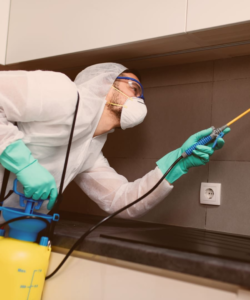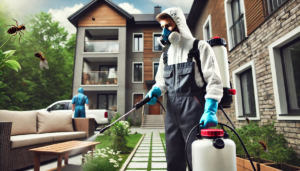Pests such as rodents and insects can cause damage to homes and businesses. They can also pose a health risk to humans by spreading diseases such as leptospirosis and hantavirus. Click https://killianpestcontrol.com/ to learn more.
Many pest control companies offer service contracts for residential customers. These contracts ensure ongoing revenue and help keep pest infestations under control.

Pest identification is the first step in any pest management situation. Proper identification provides valuable information such as the pest’s food sources, environmental conditions, harborage sites and life cycle. This information enables the development of more targeted control tactics that minimize damage to non-target organisms and the environment.
The specific method of pest identification depends on the type of pest under consideration. For example, insects can be identified by examining their mouthparts or wings, while plants may be examined for signs of damage or the presence of diseases. Field scouting, which involves observing pest activity in the field, is important for accurate pest identification. The scout’s knowledge of the pest’s biology and life cycles can also help determine when the pest is most susceptible to treatment.
Many species of pests change their appearance as they go through different stages in their life cycle. For example, a seedling weed will look very different from an adult weed. It is important to correctly identify the pest in order to develop control tactics that target the weakest points of their life cycle. This is especially important with insect pests, because they typically attack crops at certain windows of time, such as during their immature form or when the crop is entering a dormant period (Fig. 1a).
In addition, pest identification can help ensure that the correct pesticide is used. For example, if the pest is identified as forest tent caterpillars, it is important to use only products approved for that particular pest. This can help avoid harmful effects on other organisms, such as beneficial insects or non-target plants that could be harmed by unintended side effects of the pesticide. In some cases, the pest identification process is best left to professionals who can examine the pest under a microscope or with digital imaging technology, and who can advise on the most effective methods for controlling the pest without harming its host plant or the surrounding environment. Getting the identification process right will ultimately make your pest control activities more efficient and cost-effective. This will ultimately help protect your institution’s collections, staff and visitors, as well as the local ecosystem.
Pest Prevention
Pests are more than just annoying; they can cause damage to property and threaten health. They may transmit diseases like hantavirus, leptospirosis, and Salmonella to people and animals. They may also damage plants and contaminate food supplies. Hence, it is crucial to keep pests at bay in residential and commercial areas. Pest control involves a combination of prevention and treatment strategies. Prevention focuses on keeping pests from entering a space while treatments are geared towards keeping them away once they’re there.
Pest prevention typically includes inspections and routine maintenance to identify potential entry points for pests and then taking steps to eliminate these entry points. It may also include modifying landscapes to prevent pest nesting and regularly clearing debris from around buildings. It may even entail caulking openings and inspecting and maintaining trash bins. It is also important to note that some pests can be stopped from spreading by limiting the food supply to them.
Other preventive measures include using traps, screens, barriers, and fences to physically block pests from spaces. They may also entail altering the environment to make it unfavorable for the pests, such as changing the amount of available water or light. Sometimes, heat and radiation can be used to control the growth of pests.
A pest’s life cycle is also an important consideration in preventing them, since some methods are only effective at specific stages of the insect’s life. This is because some pests are capable of spreading disease or damaging property while in an egg, larvae, nymph, pupa, or adult form.
Another important factor to consider is the host, which refers to the plant or animal that a pest lives on or in. For instance, ants can spread dangerous bacteria to surfaces and food, while rats and cockroaches can carry viruses that can cause disease in people and animals. Pheromones and juvenile hormones are other natural pest controls that can be incorporated into a strategy to control the target pest.
Whenever possible, it is best to use prevention and not just treatments as the primary method of pest control. This way, the need for expensive and possibly harmful treatments will be reduced. Treatments should be used only if a pest problem has reached unacceptable levels, however.
Pest Control Treatment
Pest control involves eliminating the presence of unwanted organisms in an environment. In some cases, this may involve the use of chemical sprays, powders or baits. It is important that these substances are used sparingly, only as a last resort and by trained pest control technicians. They should be properly labelled and disposed of after use. Ideally, preventing pest infestations is the best approach.
Some natural forces influence pest populations, such as climate, natural enemies, and availability of food and water sources. For example, weather conditions affect pests by influencing the growth of their host plants. They also influence the success of certain parasitic species that feed on insect pests.
Other natural pest control methods include birds, reptiles, amphibians, fish and mammals that prey on insects and other organisms that damage crops or are considered nuisances. In addition, some fungi and bacteria can suppress populations of certain insects. Finally, pheromones, which are chemicals that attract and influence other members of the same species, can help control pests.
Clutter provides places for pests to breed and hide. It is important to eliminate weeds and shrubbery that block doors and windows, caulk cracks and crevices and repair screens. Using pest-proof garbage bags, keeping compost piles away from buildings and sealing trash containers will prevent pests from entering the home or office.
Using pheromones, repellents, and traps can help reduce the need for chemical treatment. Whenever possible, the pest control professional will try to exclude and retrain the pests rather than kill them.
When preventive steps fail to work, pest control specialists use a variety of methods to destroy the pests and keep them from returning. Typically, the method of choice is to use sprays and baits to kill the pests. However, a number of new products are available that are less toxic and have fewer side effects on humans and pets.
When a pesticide is used, it is important that the pest control technician wears appropriate personal protective equipment (PPE). This includes gloves, safety boots, a mask, and eye protection. The mask filters out particles from sprays and pesticides and helps avoid respiratory irritation. The safety boots protect the feet from chemical splashes and other physical injuries.
Pest Monitoring
Many pests are active at night or when people aren’t present, and they hide underground or in crevices. Therefore, they often go unnoticed and build up to high numbers before being discovered. Pest control measures are then needed to reduce the population and prevent further damage. This is the basis of integrated pest management (IPM). IPM programs work to monitor for pests and their damage using a variety of methods, such as scouting, trapping, and inspection. This helps to ensure that the right control measure is used at the correct time, reducing the chance of damaging non-target organisms and overusing chemical pesticides.
Monitoring may be done by a professional, but it can also be done by the pest manager or other staff. For example, in food facilities, custodial workers are asked to report any sightings of pests so they can be addressed immediately. Other areas that can be monitored for pests include schools, public buildings, residential homes, and outdoor spaces like parks, gardens, golf courses, and farms.
Different pests require different types of monitoring tools, but all monitoring should be tailored to the site or crop. For example, pests that occur in greenhouses are different from those that occur in field crops, and each situation may be affected by weather or other factors. To get the most value from a monitoring program, it’s important to place monitors in the most likely pest-vulnerable areas (PVAs), which are locations that provide the conditions for the pest to thrive. In fields, this may mean near irrigation heads or within rows. In buildings, it’s common to find PVAs in kitchens and other food-handling areas.
A basic tool for pest monitoring is a flashlight, which can help to illuminate dark or secluded areas where pests tend to live or seek shelter. A magnifying glass is also useful for identifying insect parts, frass (excrement), and other evidence of pest activity. A telescoping mirror can be especially helpful for inspecting underneath equipment or in secluded areas. Also handy is a notepad to record observations.



